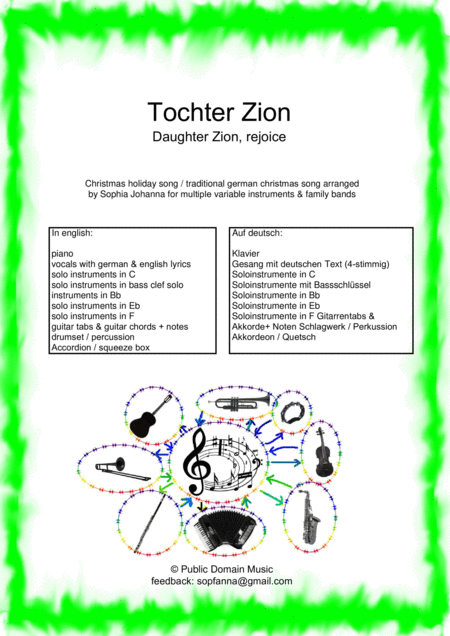Guitar,Piano,Vocal,Voice - Level 2 - Digital Download SKU: A0.851128 Composed by George Frideric Handel. Arranged by Sophia Johanna. 20th Century,Christian,Christmas,Classical,World. Score. 18 pages. Sophia Transistor #6139725. Published by Sophia Transistor (A0.851128). German traditional Christmas Song Tochter Zion, freue dich = Daughter Zion, rejoice by Georg Friedrich Händel arranged for family band or every random band with multiple various and variable instruments in every color and key.Year after year, the whole family comes together and eventually tries to perform Christmas songs on the fly. This arrangement of the traditional chistmas song Tochter Zion (Daughter Zion) offers several parts for many variable instruments in their specific notation forms. The voices can be combined ad libitum. The score also offers decent vocal scores with the original german and also english lyrics. The score includes: - Piano (piano with chordsymbols) - vocals (in german and english) choir Arrangement- solo instruments in C (violin, flute,etc.) quartet - solo instruments in bass clef (trombone, cello, bass, etc.); quartet - solo instruments in Bb(trumpet, clarinet, tenor saxophone, etc.); quartet - solo instruments in Eb (alto saxophone, Eb-clarinet, etc.);quartet - solo instruments in F (french horn, F-tuba, etc.); quartet - accordion / harmonica - guitar (notes/tabs/chord) - drumset ;-)YouTube Play Along: https://youtu.be/Pfo_Mu-8Z-sGerman description (Beschreibung auf Deutsch):Alle Jahre wieder wird mit der Familie zusammen Weihnachten gefeiert. Lasst uns doch was zusammen spielen! Na klar, hast du Noten? Ja hier, für Keyboard... hm, für mich passen die nicht... Dieses Arrangement des Weihnachtsklassikers JTochter Zion beinhaltet Noten für die gängigsten Hausinstrumente. Alle Stimmen können miteinander kombiniert werden. Die Gesangsnoten sind vernünftig notiert und den Liedtext gibt es auf Deutsch und auf Englisch.Folgende Musikinstrumente werden durch diese Noten abgedeckt: - Klavier (leicht, mittlere Begleitung, Intonationsvorschläge, Akkordsymbole und Melodie) - Gesang (auf deutsch und englisch); 3 Strophen, 4-stimmig- Soloinstrumente in C (Geige, Flöte, etc.); Quartett - Soloinstrumente mit Bassschlüssel (Posaune, Cello, Bass, etc.); Quartett - Soloinstrumente in Bb (Trompete, Klarinette, Tenorsaxofon,etc.); Quartett - Soloinstrumente in Eb (Altsaxofon, Eb-Klarinette, etc.); Quartett - Soloinstrumente in F(Waldhorn, F-Tuba, etc.); Quartett - Akkordeon / Harmonika - Gitarre (Noten/Akkorde/Tabs) - Schlagwerk / Schlagzeug / Schelleninstrument ;-)Viel Spaß beim Ausprobieren!This arrangement has been optimized for on the fly performances during Christmas time. The constitution of instruments (rhythm and solo instruments (also in transposing scores)) can be put together ad libitum. All parts are matching, can be combined or played alone.traditional german christmas children song by James Lord Pierpontarranged by Sophia Johannafor family bandPublic Domain InstrumentalLiedtext1. Tochter Zion, freue dich!Jauchze, laut, Jerusalem!Sieh, dein König kommt zu dir!Ja er kommt, der Friedenfürst.Tochter Zion, freue dich!Jauchze, laut, Jerusalem!2. Hosianna, Davids Sohn,Sei gesegnet deinem Volk!Gründe nun dein ewig' Reich,Hosianna in der Höh'!Hosianna, Davids Sohn,Sei gesegnet deinem Volk!3. Hosianna, Davids Sohn,Sei gegrüßet, König mild!Ewig steht dein Friedensthron,Du, des ew'gen Vaters Kind.Hosianna, Davids Sohn,Sei gegrüßet, König mild! Hashtags:#TochterZion#smppressmusic#Weihnachtslieder#sheetmusicplus
